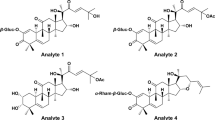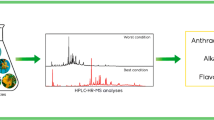Abstract
C-5-substituted and C-8-substituted furanocoumarin isomers, two important kinds of furanocoumarin, are widely documented as the main active constituents in Angelicae dahuricae radix. Due to the similar polarity and mass fragmentation pathways of such isomers, it is difficult to distinguish them using mass spectrometric methods. To address this issue, we developed a strategy employing combined full scan and product ion scan modes on an ultra high performance liquid chromatography–quadrupole time-of-flight tandem mass spectrometry (UHPLC-Q-TOF-MS) platform to differentiate four pairs of furanocoumarin isomer, viz. xanthotoxin and bergapten, imperatorin and isoimperatorin, psoralen and isopsoralen, and impinellin and isoimpinellin. A novel method using the ratio of relative abundance (RRA) of characteristic fragment ions was established to distinguish C-5-substituted and C-8-substituted furanocoumarin isomers, using the formula R = M/N, where M and N represent the ratios of relative abundance of characteristic fragment ions of a pair of furanocoumarin isomers. For R value greater than 1, compound M is substituted at C-5, whereas for R value less than 1, compound M is substituted at C-8. This method with good repeatability was applied to identify five pairs of isomeric furanocoumarins in Angelicae dahuricae radix. This is the first method to distinguish C-5-substituted and C-8-substituted furanocoumarin isomers, and can be used in complex matrix.
Graphical abstract







Similar content being viewed by others
References
Wang CM, Cui XY, Li H (2006) Anti-inflammatory Effect of Coumarins of Angelicae Dahuricae. J Beihua Univ (Natl Sci) 7:318–320
Wang MY, Jia MR, Ma YQ, Sun JM, Tang SW, Jiang GH, Xiong Y (2005) Pharmacological effect of the total coumarins in radix Angelicae Dahuricae. Li Shi Zhen Med Mater Med Res 16:954–956
Wang DC, Li K, Xu XY, Su XH (2005) Experimental study on the antipyretic-analgesic and anti-inflammatory of total coumarins from radix Angelicae Dahurica. Chin J Info TCM 12:36–37
Kwon YS, Kobayashi A, Kajiyama SI, Kawazu K, Kanzaki H, Kim CM (1997) Antimicrobial constituents of Angelicae Dahurica roots. Phytochemistry 44:887–889
Piao XL, Park IH, Baek SH, Kim HY, Park MK, Park JH (2004) Antioxidative activity of furanocoumarins isolated from Angelicae dahuricae. J Ethnopharmacol 93:243–246
Kim YK, Kim YS, Ryu SY (2007) Antiproliferative effect of furanocoumarins from the root of Angelica dahurica on cultured human tumor cell lines. Phytother Res 21:288–290
Thanh PN, Jin WY, Song GY, Bae KH, Kang SS (2004) Cytotoxic coumarins from the root of Angelica dahurica. Arch Pharm Res 27:1211–1215
Kimura Y, Okuda H (1997) Histamine-release effectors from Angelica dahurica var. dahuricae root. J Nat Prod 60:249–251
Sun MQ, Lu JQ, Zhang HG (2009) Fragmentation pathways of the furocoumarins in electrospray ionization mass spectrometry. Chin J Pharm Anal 29:82–85
Wang XG, Yang HZ, Ma SS, Ma Y, Li DF, Zhang Y, Liu YP, Xu HY (2015) Fragmentation pathways of five furocoumarins using line ion trap with orbitrap mass spectrometry. China J Chin Mater Med 40:1334–1341
Yang W, Ye M, Liu M, Kong DZ, Shi R, Shi XW, Zhang KR, Wang Q, Zhang LT (2010) A practical strategy for the characterization of coumarins in Radix Glehniae by liquid chromatography coupled with triple quadrupole-linear ion trap mass spectrometry. J Chromatogr 1217:4587–4600
Kang J, Zhou L, Sun JH, Han J, Guo DA (2008) Chromatographic fingerprint analysis and characterization of furocoumarins in the roots of Angelica dahurica by HPLC/DAD/ESI-MSn technique. J Pharm Biomed Anal 47:778–785
Liu GQ, Jing D, Wang H, Hashi YK, Chen SZ (2010) Differentiation of four pairs of furocoumarin isomers by electrospray ionization tandem mass spectrometry. Eur J Mass Spectrom 16:215–220
Sun MQ, Lu JQ, Zhang HG, Zhang QS, Xiao N, Xi RY (2010) Differentiation of four pairs of isomers by comparing their relative abundances of fragment ions. Chem Res Chin Univ 26:27–32
Ablajan K (2011) A study of characteristic fragmentation of isoflavonoids by using negative ion ESI-MSn. J Mass Spectrom 46:77–84
Gonçalves AG, Ducatti DRB, Grindley TB, Duarte MR, Noseda MD (2010) ESI-MS differential fragmentation of positional isomers of sulfated oligosaccharides derived from carrageenans and agarans. J Am Soc Mass Spectrom 21:1404–1416
Chinese Pharmacopoeia Commission (2015) Pharmacopoeia of the People′s Republic of China. China Medical Science Press, Peking
Baek NI, Ahn EM, Kim HY, Park YD (2000) Furanocoumarins from the root of Angelica dahurica. Arch Pharm Res 23:467–470
Zhang H, Gong CG, Lv L, Xu YJ, Zhao L, Zhu ZY, Chai YF, Zhang GQ (2009) Rapid separation and identification of furocoumarins in Angelica dahurica by high-performance liquid chromatography with diode-array detection, time-of-flight mass spectrometry and quadrupole ion trap mass spectrometry. Rapid Commun Mass Spectrom 23:2167–2175
Li B, Zhang X, Wang J, Zhang L, Gao BW, Shi SP, Wang XH, Li J, Tu PF (2014) Simultaneous characterisation of fifty coumarins from the roots of Angelica dahurica by off-line two-dimensional high-performance liquid chromatography coupled with electrospray ionisation tandem mass spectrometry. Phytochem Anal 25:229–240
Wei N, Yuan M, Yang HY, Zhuang XM, Sun L, Li H (2015) Simultaneous determination of six furancoumarins in Angelicae dahuricae radix using accelerated solvent extraction and LC-MS/MS. Chin J Pharm Anal 35:1385–1392
Acknowledgements
This study was financially supported by the National Natural Science Foundation of China (81102412), the Ministry of Education Key Project of Science and Technology Foundation of China (211021), Hebei Science and Technology Department (17392501D), the Hundreds of Innovative Talents Project of Hebei Education Department of China, and the Service Center for Experts and Scholars of Hebei Province of China.
Author information
Authors and Affiliations
Corresponding authors
Ethics declarations
Conflict of interest
The authors declare no conflicts of interest.
Ethical approval
This article does not contain any studies with human participants or animals performed by any of the authors.
Electronic supplementary material
Below is the link to the electronic supplementary material.
Rights and permissions
About this article
Cite this article
Tian, Y., Shi, R., Gao, M. et al. Differentiation of Furanocoumarin Isomers with Ratio of Relative Abundance of Characteristic Fragment Ions and Application in Angelicae dahuricae Radix. Chromatographia 80, 1401–1410 (2017). https://doi.org/10.1007/s10337-017-3348-5
Received:
Revised:
Accepted:
Published:
Issue Date:
DOI: https://doi.org/10.1007/s10337-017-3348-5




